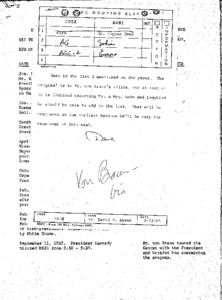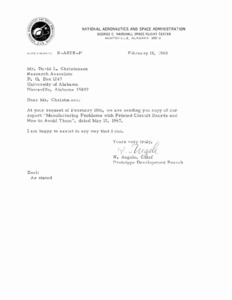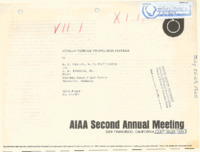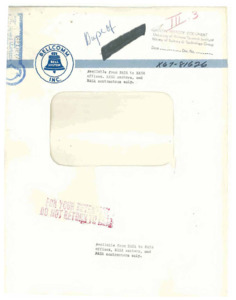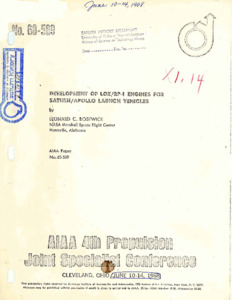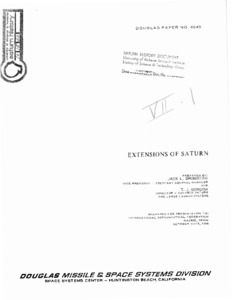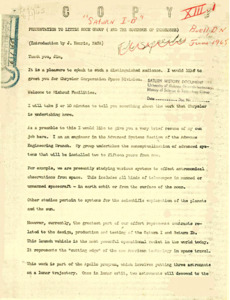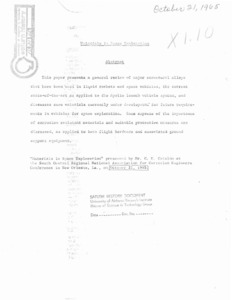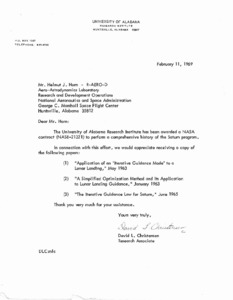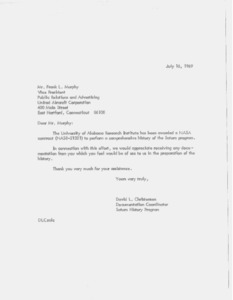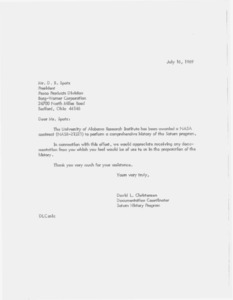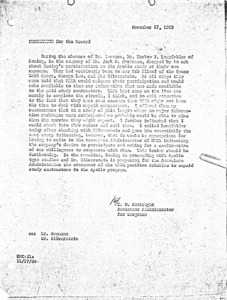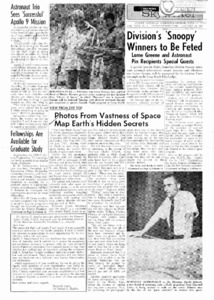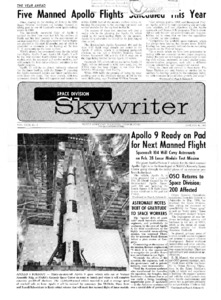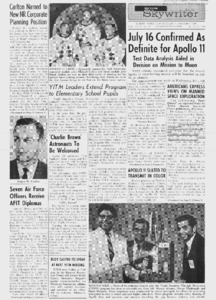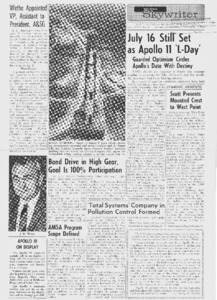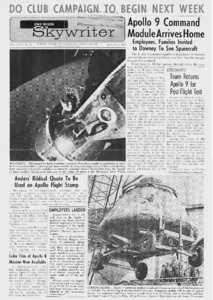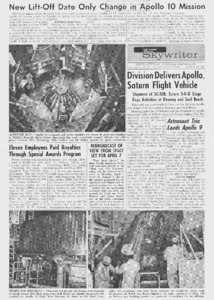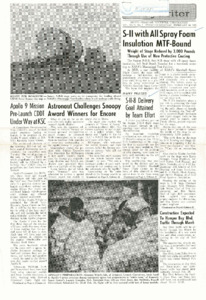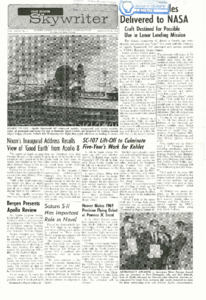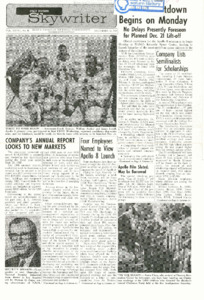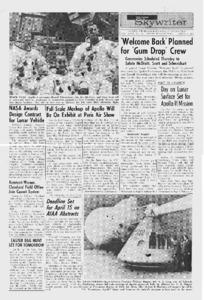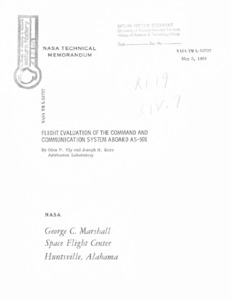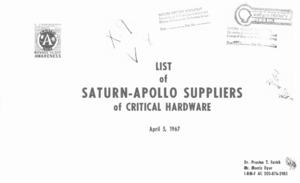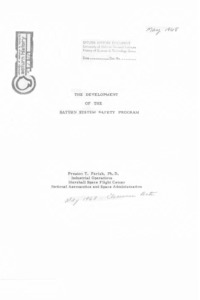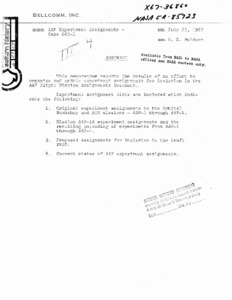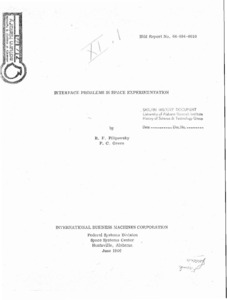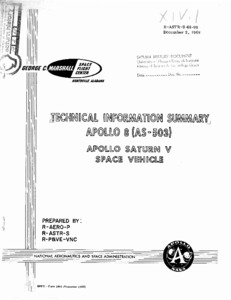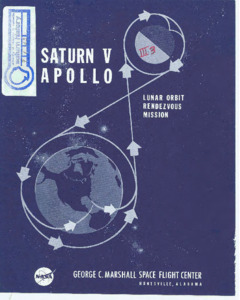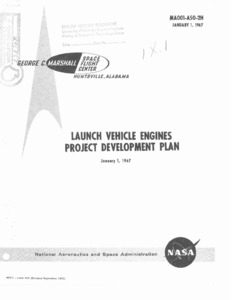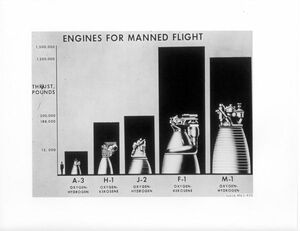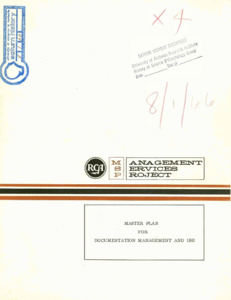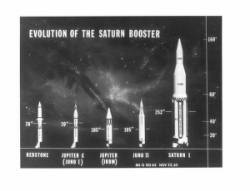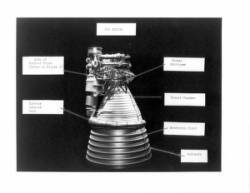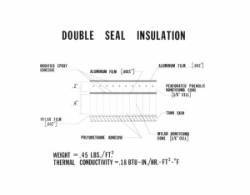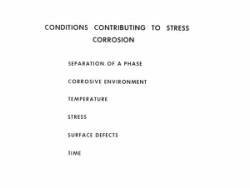
Browse Items (156 total)
Sort by:
-
Dr. von Braun's calendars and scrapbooks indicate that these were his personal contacts with President Kennedy, Vice-President Johnson and members of their immediate staff.
The first page contains a typed routing slip. A list of Wernher von Braun's meetings with President Kennedy, the Vice President and members of their immediate staff. -
"Letter to Mr. David L. Christensen."
Letter David L. Christensen from W. Angele responding to a pervious request. -
"Apollo Vehicle Propulsion Systems."
This paper discusses the propulsion requirements for various stages of the Apollo vehicles and the development of these engines. -
"Preliminary skeletal operations plan for Apollo :" a systems engineering support document.
The Preliminary Skeletal Operations Plan is a statement of the operational concept for Apollo. This draft contains a description of the conduct of the Apollo LOR landing mission and a mission profile. It provides the basis for more detailed mission planning, for generating functional criteria for equipment design, and for measuring the adequacy of the current Apollo hardware for satisfying operational needs. -
Development of LOX/RP-1 engines for Saturn/Apollo launch vehicles.
The development of liquid rocket engines follow similar patterns regardless of engine size. During the development of the H-1 and F-1 engines, may problems were encountered. Mehtods of solving the combustion instability problem are discussed.; AIAA 4th Propulsion Joint Specialist Conference, Cleveland, Ohio, June 10-14, 1968.; Also available on NASA Technical Reports Server (NTRS) as unclassified. Can be ordered. Also on AIAA. -
"Extensions of Saturn."
This paper discusses the possible applications of Saturn vehicles to future space exploration. Potential missions utilizing Apollo derived hardware are examined. Research, development, and operations in earth orbit as well as lunar exploration, unmanned and manned interplanetary exploration are reviewed. These hypothetical missions are discussed in the context of the present and potential capability of three configurations of the Saturn vehicle; an uprated Saturn I, a three-stage Saturn V and a four-stage Saturn V. NOTE: Work presented herein was conducted by the Douglas Missiles and Space Systems Division under company-sponsored research and development funds. Therefore, the concepts and objectives described within this paper reflect the opinions of the authors and do not necessarily constitute endorsement by NASA, the Air Force, or any other U.S. Government organization. The nominal performance numbers presented are typical of the current configurations and possible future vehicle configurations. -
"Saturn IB : presentation to Little Rock Group."
Speech by H.D. Lowrey, SAE Meeting, Detroit, Michigan. Focuses on the Apollo project, the technology involved and what the goals of the project are. -
"Materials in space exploration."
This paper presents a general review of major structural alloys that have been used in liquid rockets and space vehicles, the current state-of-the-art as applied to the Apollo launch vehicle systems, and discusses some materials currently under development for future requirements in vehicles for space exploration. Some aspects of the importance of corrosion resistant materials and suitable protective measures are discussed, as applied to both flight hardware and associated ground support equipment. -
"Saturn Apollo guidance error estimation."
A brief sketch of the development of the equations for a weighted least squares estimator is given, the equations for both collective and recursive estimators being included. Four possible problem sources that may be encountered in the application of the estimator are identified. Various "success" parameters are defined in an attempt to predict the success with which, the method has been applied. The application of the estimation technique to the problem of computing various error parameters associated with the ST-124M guidance platform is described with the numerical results obtained using a manufactured data case are presented. These results are used to form conclusions about the effectiveness of the "success" parameters and preferred approaches to the problem of system evaluation using techniques of estimation theory. -
"Letter to Mr. Helmut J. Horn."
Letter to Helmut J. Horn from David L. Christensen informing that the University of Alabama Research Institute was awarded a NASA contract. -
"Letter to Mr. Frank L. Murphy."
Letter to Frank L. Murphy from David L. Christensen informing an awarding of a contract as well sa requesting documents. -
"Letter to Mr. D. R. Spotz."
Letter to D. R. Spotz from David L. Christensen informing an awarding of a contract as well sa requesting documents. -
"Memorandum for the record, from E. M. Cortright, Assistant Administrator for Programs."
Poor photocopy. Memorandum informing that members of the Boeing company are coming by for a study of their own. -
"The significance of parameters affecting the heat transfer to the liquid hydrogen in the Saturn S-IVB stage for the lunar orbit rendezvous mission."
The Saturn S-IVB stage has a requirement for orbiting around the earth for up to 4.5 hours with approximately 60 percent of its initial propellant remaining at the end of the coast (prior to restart) . Extensive analyses must be performed to insure that this requirement is met. Both the maximum and minimum heat transfer rates are important because the maximum rates affect the hydrogen boiloff losses and thus the initial propellant loading requirements. The minimum rates are important because the boil off gases are used to maintain a minimum axial thrust level by venting the gases continuously through aft facing nozzles. This provides for a settling of the propellant throughout the orbital coast and alleviates the need for periodically venting the tank under zero gravity. -
"Astronaut trio sees 'successful' Apollo 9 mission."
News article detailing the hope from the Apollo 9 crew that their mission will be a success. -
"Five manned Apollo flights scheduled this year."
News article detailing the planning of five more projects after the successful mission of Apollo 8. -
"July 16th confirmed as definite for Apollo 11."
News article covering NASA's announcement of Apollo 11's launch-date: July 16th. -
"July 16th still set as Apollo 11's 'L-Day.'"
News article confirming NASA's announcement of Apollo 11's launch-day. Focuses on the optimism surrounding the launch as well. -
"Apollo 9 flight ends; Astronauts return."
News article detailing the recovery of the Apollo 9 crew after their mission -
"Apollo 9 command module arrives home."
News article detialing the recovery of the Apollo 9 command module and the events planned around its display. -
"New Liftoff date only change in Apollo 10 mission."
News article detailing the slight change in schedule regarding the Apollo 10 lunar module's take-off from the Moon and its return to Earth. -
"SII, with all spray foam insulation MTF-bound."
News article detialing the innovation of the SII's design, specifically how it is made lighter. -
"Craft destined for use in lunar landing mission."
News article detailing how the Apollo spacecraft 107 command modules are planned to be used in future space-missions. -
"Apollo countdown begins on Monday."
News article detailing the interest around the liftoff of the Apollo 8 spacecraft. -
"Welcome back planned for 'Gum drop' crew."
News article detailing the planned 'Welcome back' events surrounding the resturn of the Apollo 9 crew. -
"Flight Evaluation of the Command and Communication System Aboard AS-501."
The first test of the command and communications system, a unified frequency S-band system, aboard AS-501 was successful. Compatibility of this system with the MSFN/USB sites was established. The onboard transponder and antenna system including antenna switching performed as predicted. The command performance was excellent with 5747 valid commands received onboard out of 5748 commands transmitted. Data reduction problems prevented a complete analysis of the tracking data. Telemetry system performance was satisfactory with a measured bit-error-rate of 4 x10-5 while over the Ascension Island station. This flight provided valuable data which can be used to define vehicle to-ground-station interfaces, to establish attitude constraints during translunar injection, and to improve operational procedures. One more test as successful as the AS-501 test would qualify the system as operational.; May 3,1968. -
"List of Saturn-Apollo Suppliers of Critical Hardware."
A list of critical hardware from Saturn-Apollo Suppliers. -
"The development of the Saturn system safety program."
This paper describes the major highlights or milestones passed in the development of a System Safety Program at MSFC since early 1967. it discusses accomplishments, problems resolved, and decisions made for Apollo Saturn vehicles AS-501 and AS-502, and projects that are to be accomplished on future Saturn vehicles. -
"Memorandum : AAP experiment assignments - Case 600-1."
This memorandum reports the results of an effort to organize and update experiment assignments for inclusion in the AAP Flight Mission Assignments Document. Experiment assignment lists are included which indicate the following: 1) Original experiment assignments to the Orbital Workshop and ATM missions - AAP-1 through AAP-4; 2) Mission AAP-1A experiment assignments and the resulting unloading of experiments from AAP-1 through AAP-4; 3) Proposed assignments for inclusion in the draft FMAD; 4) Current status of the AAP experiment assignments.; X67-36860.; NASA TR - 85723. -
"Interface Problems in Space Experimentation."
Space experimentation is expanding rapidly. Unmanned satellites are being equipped with precision instruments of greater power, and manned space stations accommodating large crews are in the drawing-board stage. The interface problems between these sophisticated instruments and between man, the spacecraft, and the supporting groundstations are multidimensional. This paper analyzes the scientific/technical areas of space experimentation, and continues with a review of the subsystems and support systems required to supply and operate the large variety of instruments. Areas of major integration efforts are singled out and the requirements for further developments and improvements are listed. A bibliography of 95 references is enclosed to assist in the identification of more detailed reports on all vital aspects of space experimentation.; Archive copy is a photocopy.; Supplement to IEEE Transactions on Aerospace and Electronic Systems, Vol. AES-2, No. 4, July, 1966. Pages 237 to 255. -
"Technical Information Summary Apollo 8 (AS-503) Apollo Saturn V Space Vehicle."
This document is prepared jointly by the Marshall Space Flight Center laboratories R-AERO-P, R-ASTR -S, and R-P&VE-VN . The document presents a brief and concise description of the AS-503 Apollo Saturn Space Vehicle. Where necessary, for clarification, additional related information has been included. It is not the intent of this document to completely define the Space Vehicle or its systems and subsystems in detail. The information presented herein, by text and sketches, describes launch preparation activities, launch facilities, and the space vehicle. This information permits the reader to follow the space vehicle sequence of events beginning a few hours prior to liftoff to its journey into space. -
"Saturn V Apollo lunar orbit rendezvous mission."
Diagram explaining the process of a lunar mission from liftoff to recovery. -
"Launch Vehicle Engines Project Development Plan."
This revised edition of the Launch Vehicle Engines Project Development Plan supersedes the issue dated July 1, 1965. Significant changes which have been made are:- Removal of classified data to permit publication as an unclassified document; - Removal of material applicable to the RL-10 Engine Project which was transferred to the Lewis Research Center effective May 1, 1966; - Elimination of detailed schedules which quickly become obsolete; - Punched for maintenance in loose-leaf 3-ring binders and for ease in updating material through issuance of replacement sheets. Binders are not furnished. The information in this document is current to January 1, 1967.; The Launch Vehicle Engines Project Development Plan is established in accordance with requirements of NASA General Management Instruction 4-1-1, Planning and Implementation of NASA Projects, and OMSF Instruction MP 9320.044, Preparation and Revision of Program/Project Development Plans (PDP's). The Plan, herein referred to as the PDP, has been developed within the scope of current Apollo Projects Approval Documents (PADS) and will be maintained by the Engine Program Manager to identify program requirements, responsibilities, tasks, and resources, and time phasing of major actions required to accomplish the Engine Program. -
"Engines for Manned Flight."
8 x 10 inch black and white photograph.; Images included are: A-3 oxygen-hydrogen, H-1 oxygen-kerosene, J-2 oxygen-hydrogen, F-1 oxygen-Kerosene, M-1 oxygen-hydrogen. The thrust pounds is also listed.Shows them in reference to a human as a scale. -
"First Annual Logistics Management Symposium: September 13 and 14, 1966."
The proceedings of the First Annual Logistics Management Symposium are forwarded with the hope that the information will be of assistance to attendees and their staffs in the planning and management of logistics support programs. I recognize that there is still much study required before all management techniques and procedures for support programs are known and understood, but I believe that support problems are made easier by exchange of knowledge. The Symposium was based on this belief and we plan to continue the search for ways to achieve better program support at a lower cost. Edmund F. O'Connor, Director, Industrial Operations. -
"Master plan for documentation management and use."
Prepared for National Aeronautics and Space Administration, George C. Marshall Space Flight Center, Huntsville, Alabama. Accepted by V.C. Sorensen, Chief, Management Services Office. Management Services Project, RCA; SUMMARY: The objective of this study is to describe a comprehensive plan for the development and full utilization of methods and means to be employed in the years prior to 1976 for the effective acquisition, collection, storage, retrieval, distribution, and use of engineering documentation. Because of the violently changing state of the art of data acquisition, storage, and retrieval the description of the plan does not embrace the details of a total decade of phased change. Rather it describes actions that can and should be taken in the relatively near future, and proposes a continuing series of later studies to keep this plan current for the full decade. -
"Evolution of the Saturn Booster."
8 x 10 inch Black & White photograph. MS-G 103-63 Nov. 22, 63 is on the photograph. Displays the evolution of space-rocket designs side-by-side. -
F-1 engine photograph.
8 x 10 inch black and white photograph. Engine parts are labeled. -
Double seal insulation [drawing] photograph.
8 x 10 inch black and white photograph.; Drawing contains information about the modified epoxy adhesive, aluminum film, mylar film, perforated phenolic honeycomb core, tank skin, mylar honeycomb core, polyurethane adhesive, weight and thermal conductivity.; Photo negative no. 651746 M-268. -
"Conditions contributing to stress corrosion [list] photograph."
8 x 10 inch black and white photograph. A photograph of a list of things contributing to stress corrosion. Referenced by "Materials in Space Exploration." Is part of envelope containing photos accompanying C. E. Cataldo paper "Materials in Space Exploration."
